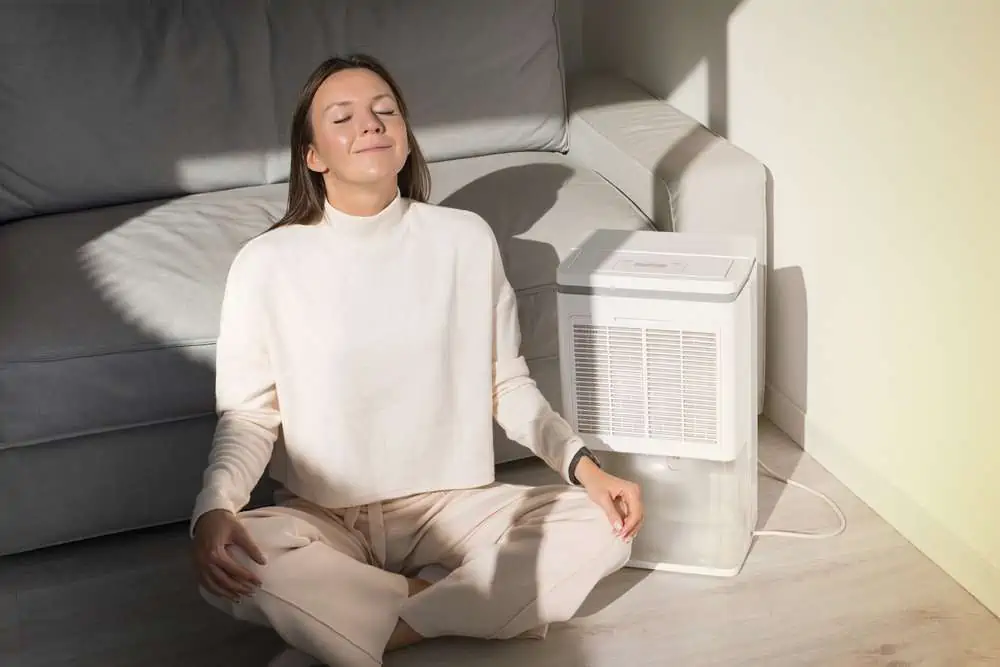Did you know that inhaling paint fumes can lead to nausea, headaches, and kidney damage in case of prolonged exposure?
Knowing how to get rid of the spray paint smells is crucial if you plan on using it. Let’s see what spray paint fumes can do to your health and how to deal with them.
Key Takeaways
- Properly ventilate the area by opening windows and using air purifiers to reduce spray paint smell.
- Choose low-VOC spray paints to minimize toxic fumes.
- Place activated charcoal, bowls of lemon water, or baking soda in the room to absorb odors.
- Ensure paint cans are sealed and stored properly, and allow each layer of paint to dry before applying another.
Is Spray Paint Toxic After It Dries?
When eaten or inhaled, paint does pose the risk of causing potential injury to the body, particularly oil-based paints. But once dried, the fumes neutralize and dissipate, so there is no risk of being toxic.
A slight smell can linger for a few days, especially if the space isn’t ventilated. Just open a window to air it out.
Is It Safe to Use Spray Paint Indoors?
Yes, if you do it correctly. Ensure the room is properly ventilated and wear safety gear that prevents inhaling any spray paint fumes (invest in a good protective mask).
Inhaling fumes can lead to breathing problems, dizziness, nausea, and headaches in the short term. As for the long-term effects, these include kidneys, liver, and nervous system damage.
Also make sure you have adequate space. You don’t want to run out of room if you have multiple items to paint. To avoid a mess, place everything on cardboard or on wood you don’t need.
How to Get Rid of Spray Paint Smell
There are a few different methods you can try when figuring out how to get rid of spray paint fume.
1. Proper Ventilation
To improve air circulation in the space where you are painting, open as many windows and doors as possible. Ventilation on its own is likely to have a greater effect on the offensive odor than on the potentially harmful substances.
Fumes circulating in a room while painting are dangerous, but even more fumes are released into the air as the spray paint dries and evaporates. So, although the odor may have vanished after opening a few windows and directing fans toward them, don’t be fooled into staying in the room.
Good To Know
Avoid using a home fan while you are painting. The chemicals may damage the fan and, in extremely unusual circumstances, could cause a fire. Instead, opt for an industrial fan, as they are explicitly designed for use in situations like these.
2. Low-VOC Paint
Choosing a paint with a low volatile organic compound (VOC) content is the more defensive strategy and can be supplemented with a purifier. Low-VOC paint means using low-odor products that can help reduce toxic smells.
This strategy entails reducing the number of volatile compounds that are released. When the paint has a lower concentration of volatile chemicals, there will be less off-gassing and fewer fumes as it dries.
Look for labels that say “low-VOC” on them. Many brands have these, including Kilz, Behr, Sherwin-Williams, and Benjamin Moore.
It’s best to steer clear of using oil-based paints whenever possible because these types typically produce more paint fumes.
3. Air Purifiers
An air purifier is the best odor eliminator out there, but you must pay close attention to what filters they use. Some air filters can only remove larger particles that may still be present in the air, while others can extract volatile organic compounds from aerosol sprays.
You will require a HEPA filter, and you will need to replace that filter at the frequency that the manufacturer recommends.
If you choose a filter that is only of low quality and is designed to remove dust particles, you will not be able to remove any harmful gasses. If you want to protect your health, you shouldn’t be seeking the least expensive solutions.
4. Coffee Grounds
Make use of fresh coffee grounds and position them in an area of the room that has good air circulation.
This aroma from the coffee beans will permeate the entire space and soak up paint vapors at the same time.
5. Baking Soda
There’s a reason why many home cleaning articles will teach you to remove odors from your fridge or oven using baking soda. The desiccant (a substance that absorbs water) properties of baking soda also helps it to absorb fumes and odors. Place small bowls of baking soda around the freshly painted room.
6. Lemon Water
Add lemon juice to bowls of water and let it sit; it can help minimize the scent by absorbing some of the odor. But note that it offers very little protection against fumes.
On the bright side, putting it into action is easy as pie. Cutting up a fresh lemon rather than using a solution containing lemon water is strongly recommended.
7. Activated Charcoal
Charcoal might also be a great solution when it comes to getting rid of putrid odors. But it’s essential to use activated charcoal. Once activated, it becomes more porous, indicating that it can fully absorb the odors and fumes present in its immediate environment.
Crushed charcoal doesn’t have the same pockets of oxygen that generate space for odor absorption. So, it is not as effective at removing paint’s stench as activated charcoal.
8. Natural Extracts
Peppermint and vanilla are two natural extracts that could eliminate paint odors and make the air in the room feel fresher. Put a few drops of the extract onto cotton balls, and then arrange the cotton balls in various dishes or saucers about the room.
Before beginning the painting task, some painting experts recommend directly putting one or two drops of the extracts into the can of paint to help decrease the paint’s pungent odor and leave the room smelling like new.
How to Get Rid of Spray Paint Smell on an Item
So, now you know how to eliminate spray paint fumes from the room. But what if the smell is lingering on the freshly painted item?
Odor on Fabric
When cleaning stains and the smell of paint from your clothes, you shouldn’t just rely on standard laundry detergent. Baking soda, vanilla extract, vinegar, borax, and cinnamon are some materials frequently employed in eliminating the odor of paint from fabric.
Add one of the ingredients to hot water and let the fabrics soak. Then put it through a normal washing cycle.
Odor on Furniture
To remove paint odors from wooden furniture, mix two parts of water with one part of vinegar and apply it to the surface. Rinse immediately to prevent damaging the coat of paint.
Odor on Plastic
To eliminate the smell of spray paint, you can choose to implement any of the solutions presented in this article. It is possible to eliminate the odor of spray paint by placing activated charcoal, vinegar, or lemon water near the plastic item.
Odor on Metal
Vinegar can eliminate the odor of paint from metal, but if too much is used, it could also remove the actual paint. Because of this, you must water down the solution and only use a very small amount.
It is important to wait until the paint has completely dried before applying the vinegar solution. You need to wait longer if the paint is still tacky to the touch after applying it.
When the surface is completely dry, apply a thin layer of a solution made of water and vinegar to the metal surface.
How to Prevent Spray Paint Smell
Aside from learning how to get rid of spray paint fumes, you might want to check out a few methods to prevent them.
1. Ventilation
Always open doors and windows while you paint, regardless of what type of paint or painting method you employ. Even better, paint outside if possible.
2. Low-VOC Paint
You should look for paints that have zero or low levels of volatile organic compounds (VOCs) to reduce the number of paint fumes produced.
In addition to producing fewer paint fumes, they also minimize the number of chemicals and contaminants that can cause allergic reactions, making them a healthier alternative to conventional paints.
These types of paint are good to use in regions that do not have adequate ventilation, such as basements.
3. Closed Lids
An often-overlooked precaution to take in the house is to ensure the lids of all paint cans are securely fastened.
If the lid is left off, air can still enter the can, causing the paint inside to dry out more quickly while also allowing the paint’s odor to escape. Be careful to seal your paint cans and store them in a cold and dry place.
4. Cool Temperatures
Paint will dry more slowly when there is a high humidity level, gradually generating a bad odor. If the project takes a while, the fumes could transfer to other items or locations, such as curtains or a sofa, causing the fabric to smell unpleasant.
To get around this problem, try to start your painting project on a day when the temperature is lower, or make sure to dry your rooms as quickly as possible by using a fan.
5. Dry Layers
Paint that is still wet gives off pungent odors and normally requires several hours to dry completely. It is important to give each layer of paint sufficient time to dry to cut down on the number of fumes and odors produced.
6. Turn Off AC Units
Paint fumes being sucked up by your AC unit and then being recirculated is the last thing you want to worry about.
During the time that you are painting, you should ensure that the air conditioner and any air vents in rooms that are next to the room that is being painted are switched off and closed.
Does Spray Paint Smell Go Away?
The length of time that spray paint’s odor will remain is highly variable on the circumstances.
A room with enough ventilation will retain the fragrance for a couple of days. But the stench will linger for much longer in a room sealed off before and after the spray-painting process.
After painting, the odor will often start to go away gradually after 24 hours, and if all goes according to plan, the scent should be completely gone within two to three days.
Remember that these estimations are for spray painting done inside. When painting outside, the constant movement of the wind will prevent the paint odor from accumulating as it would if you were painting inside.
The Verdict
Now that you know how to get rid of spray paint smell, it’s all a matter of trying out different methods to see what works for you. Fast odor removal might not always be an option, so learn to be patient and trust the process.












